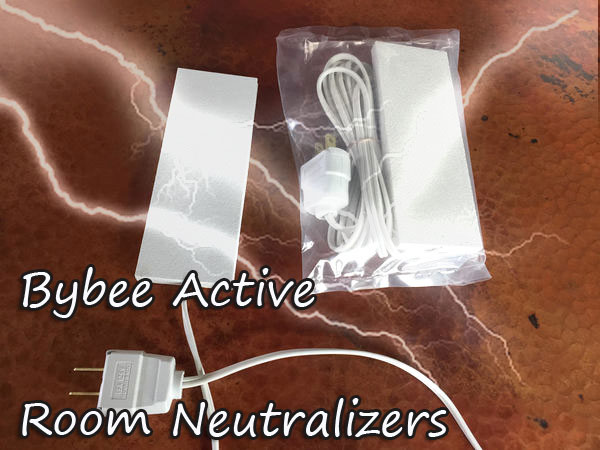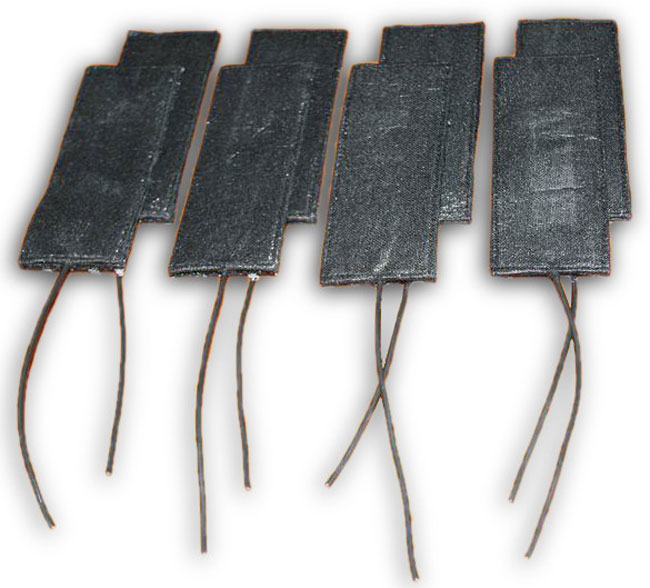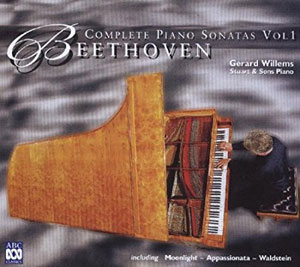Bybee Active Room Neutralizers


 My original review of Jack Bybee’s Room Neutralizers (here) goes into a little detail about the theory of their operation, which I will not repeat, except for the following passage: The pivotal concept here is compliance, “…a measure of the ability of a mechanical system to respond to an applied vibrating force, expressed as the reciprocal of the system’s stiffness.” The term “compliance” is familiar as applied to the ability of a phono cartridge stylus to accurately track the grooves in an LP. In this case, however, it applies to the ability of a medium (air) to transmit vibrations (sound pressure waves) with minimal frequency-specific time and waveform distortion. Bybee figured that if air could be made more compliant, then all audio frequencies would travel at the same rate of speed and remain coherent relative the source (loudspeaker).
My original review of Jack Bybee’s Room Neutralizers (here) goes into a little detail about the theory of their operation, which I will not repeat, except for the following passage: The pivotal concept here is compliance, “…a measure of the ability of a mechanical system to respond to an applied vibrating force, expressed as the reciprocal of the system’s stiffness.” The term “compliance” is familiar as applied to the ability of a phono cartridge stylus to accurately track the grooves in an LP. In this case, however, it applies to the ability of a medium (air) to transmit vibrations (sound pressure waves) with minimal frequency-specific time and waveform distortion. Bybee figured that if air could be made more compliant, then all audio frequencies would travel at the same rate of speed and remain coherent relative the source (loudspeaker).
What does all this mean? Firstly, it is a given that you want to hear exactly what’s coming from the loudspeaker, nothing added, nothing taken away. It is fundamental to the audiophile’s credo: reproducing the data on the medium with the greatest possible truthfulness (fidelity). But it is undeniable that, due to the imperfect compliance of air, what you hear is “distorted” in a sense (or, if you prefer, modified) because it travels through the air. That is to say, different frequencies travel at different speeds (phase distortion) and attenuate at different rates (amplitude distortion). Of course ordinary ears cannot actually differentiate any of this; somewhat like that digital bugaboo jitter; one readily recognizes it only by its reduction.
Nit picking at its worst, perhaps. After all, air is everywhere, in my living room, in your living room, as well as in The Royal Concertgebouw. But, as coffee aficionados know, the proof is in the cup. Or in this case, in the listening: the effect of increasing room air compliance (still a theoretical proposition, as far as I know) is audible and quite unlike anything I’ve heard by changing components, cords or cables. Not only are the various aspects of sound quality improved, but the room itself behaves in a remarkable fashion: the perceived boundaries expand, even disappear. Exactly how this works I’ve no idea.
There is probably no such thing as perfect compliance, but there is a range (discrete or continuous) of compliance among physical objects. I think the primary difference between the active and passive versions of the Bybee Room Neutralizer is the how compliant each renders a given volume of air. They both do the same thing; the active version does more of it.
Among the technical details mentioned in the earlier review is Bybee’s (scientifically grounded) speculation that the activating factor for the proprietary materials inside a neutralizer is stray electro-magnetic fields. Here on planet Earth you probably can’t get away from these, even if you want to. I suppose you could take up residence inside a room with mu-metal walls, floor and ceiling; that might shield you from low level EMF (of course you’d have to leave your cell phone outside). But what if you wanted the opposite, what if you wanted to intensify EMF for audiophile purposes?

This is, I believe, precisely what lies behind Bybee’s redesign of the room neutralizer. Two passive room neutralizers are glued together forming a single, thicker device with two wires sticking out the bottom and several feet of zip cord, terminated with a specially treated AC plug, wired to each of the respective “antennae”. In itself this arrangement probably more than doubles the effectiveness of a single passive RN. But when the other end of the zip cord is plugged into an AC outlet, two things apparently happen.
First, although I do not know if the wires exiting RNs are for transmission or reception of energy, or for both, plugging them into literally miles of electrical wiring creates a giant antenna system. Second, I’ve no idea whether the materials inside a RN are conductive, but it may be that two bonded neutralizers act somewhat like the plates of a capacitor, alternately charging and discharging at the frequency of the electrical system (60 or 50 hertz). This would create a far more intense electromagnetic field between the “plates” than random EMF does, highly activating the proprietary materials inside. A single, Active Room Neutralizer (ARN) is equivalent to multiple passive units. Certainly such is my subjective experience.
 Beethoven: Piano Sonatas, Gerard Willems, Stuart & Sons pianoforte (ABC 465 077-2). A good part of my 2005 review of these sonatas was taken up with the instrument itself, a concert grand designed and built by Wayne Stuart in Australia. This is a uniquely beautiful instrument, visually as well as sonically, lacking the homogeneous voicing that’s been de rigueur for more than a hundred years, and employing a patented agraffe design that both encourages vertical plane vibration and enables the use of a thinner soundboard, both of which contribute to sustain and overtones. I spent months with these CDs and really got to know the sound of this instrument. As well, I’ve turned to this set numerous times in reviewing cords and cables and components and tweaks. Nevertheless, last night when I played the first movement of the Waldstein, both of us were rendered speechless for awhile. The sound of the piano was wonderful, and was at the same time familiar and unfamiliar.
Beethoven: Piano Sonatas, Gerard Willems, Stuart & Sons pianoforte (ABC 465 077-2). A good part of my 2005 review of these sonatas was taken up with the instrument itself, a concert grand designed and built by Wayne Stuart in Australia. This is a uniquely beautiful instrument, visually as well as sonically, lacking the homogeneous voicing that’s been de rigueur for more than a hundred years, and employing a patented agraffe design that both encourages vertical plane vibration and enables the use of a thinner soundboard, both of which contribute to sustain and overtones. I spent months with these CDs and really got to know the sound of this instrument. As well, I’ve turned to this set numerous times in reviewing cords and cables and components and tweaks. Nevertheless, last night when I played the first movement of the Waldstein, both of us were rendered speechless for awhile. The sound of the piano was wonderful, and was at the same time familiar and unfamiliar.
There was more dynamic nuance and tonal subtlety, more ambient detail, and much more image precision; even the voicing sounded different, as if the ratios of the overtones of the vibrating strings was altered. (This is not as far fetched as it may seem. The unique “sound” of any musical instrument is made up of a fundamental frequency and a characteristic set of overtones. It is logical that a change in the compliance of the air will effect the propagation of individual overtones slightly differently, slightly altering the characteristic sound of the instrument.) Spatial clues were more plentiful, creating a more palpable and stable image. Tonal quality was radiant. This was singularly pure music, sound that enraptures all of one’s sensual attention. A audiophile lives for moments like this.
 Gabriel Fauré: Requiem, Robert Shaw, Atlanta Symphony & Chorus (Telarc CD-80135).
Gabriel Fauré: Requiem, Robert Shaw, Atlanta Symphony & Chorus (Telarc CD-80135).
The Fauré Requiem is one of the masterpieces of last century, a testament to a calm and profound faith. A faith not all that readily found in these incongruous and reactionary times. It is music that calms and heals the weary spirit, unburdened by dogma or trepidation. This 1987 performance, with soprano Judith Blegen and bass James Morris, is a classic, conducted by the great choral leader Robert Shaw. I have always found loud choral music particularly challenging to reproduce due to the complexity of the texture combined with the poor acoustics of our living room. But one aspect, at least, of room acoustics—subjective room size—is altered by the presence of the ARNs. This phenomenon is certainly audible with passive RNs, but with the electrified version is much enhanced. The sound stage is huge, the locus of individual instruments and singers very precise and stable.
I was particularly taken with the Libera me. The sheer beauty and presence of the bass soloist actually standing there fifteen feet or so behind the plane of the loudspeakers, is an experience to be cherished. I had tears in my eyes. Imaging of this caliber may be standard fare where you live, but around here, it’s bloody miraculous. How does increasing the energy levels of nitrogen molecules make my living room walls fade away and ambient images stabilize? Alas, life comes without a user guide that contains the answers to our questions.
 After a few days I became curious to discover what the ARNs would do without my set of passive RNs arrayed on the walls and on the back of the loudspeakers. And I thought it might be of interest to you as well, since you might like to know what buying a single pair of ARNs may do for your stereo.
After a few days I became curious to discover what the ARNs would do without my set of passive RNs arrayed on the walls and on the back of the loudspeakers. And I thought it might be of interest to you as well, since you might like to know what buying a single pair of ARNs may do for your stereo.
So I removed all eight passive units, not just from the living room, but from the house. I also unplugged and removed the ARNs. And I waited to allow time for the nitrogen molecules in the house to normalize energy levels before further auditioning. (For all I know, this transition from high to normal energy level happens instantly. But that’s the point, I don’t know.)
A couple of days later, an unseasonably cold December morning, I lit a fire and when the room had warmed, I played a Beethoven sonata from the same set. I can’t say the sound quality was lacking in any obvious way, it was excellent; but that intangible factor, call it excitement or delight or involvement, was not very evident. Ivor Tiefenbrun used to say that the important question was, Does it make you tap your foot to the beat? (This is perhaps what current audio reviewers refer to as PRaT.) After awhile I grabbed the ARNs, plugged them in and set them atop my subwoofers, while the music played on.
Hey presto, back came the magic. The piano took on body and locus and, especially, coherence. It was, in a word, more present. And the shift was far from subtle. It was noticeable immediately the ARNs were activated, and over the next few minutes seemed to increase in intensity. (A highly subjective statement, that.) A single pair of Active Room Neutralizers changed the overall character of this stereo (or, more accurately, the character of this room).
I don’t know that there’s a procedure to test air for compliance; perhaps measuring the speed differential and phase of different frequencies, with and without Room Neutralizers present in the room. And perhaps like other perceived audible changes, the ear is more sensitive than any measuring instrument and what one hears is, quite simply, unmeasurable.
Next I played the Libera me and examined the image with great care. It seemed to me that the image had been more spacious and defined the other day, when both ARNs and RNs were working together. This is not surprising. Nevertheless, bearing in mind the onerous limitations of comparing sounds separated by a gap of several days, it was my strong impression that two active RNs did a better job than eight passive RNs had done during the previous months.
 Ludwig van Beethoven: String Quartet in E flat major, Opus 74, “The Harp,” The Alexander String Quartet (Foghorn Classics CD1999).
Ludwig van Beethoven: String Quartet in E flat major, Opus 74, “The Harp,” The Alexander String Quartet (Foghorn Classics CD1999).
My affair with Beethoven’s quartets goes back nearly sixty years but remains evergreen. This music still fills me with humility and gratitude, and a disquieting awareness of just how courageous and honest the human spirit can be. Reminds me of Rilke’s line, You must change your life. I used to think that, if only we all could listen, truly hear this music, the world would change utterly.
The “Harp” quartet is from the middle set and is a favorite. There was a period of three or four months during which I listened to nothing else, first one version, then another. They’re all great, but I particularly like the ‘cellist in the Alexandria set, Sandy Wilson. He’s got that wild streak I have always liked, particularly in a ‘cellist. This CD has never sounded like this before. Indeed, the dynamics, the tactility of the instruments, their insistent presence clearly defined in space, is beyond anything I’ve heard on this system. In retrospect, imaging before the ARNs seems confined and foreshortened.
 I was provided no proprietary information concerning differences between the neutralizers used in the passive versus the active devices, but there are some differences between them. First, I noticed that two passive units aligned face to face are noticeably thicker than an active unit, which consists of two units glued together. Then, Jack told me there were “minor differences” in the active materials used. As well, because of the slightly thinner encapsulation, the active elements are probably in closer proximity. For both these reasons, two passive neutralizers glued together is not quite the same as one factory-made active neutralizer. I did not test for these differences.
I was provided no proprietary information concerning differences between the neutralizers used in the passive versus the active devices, but there are some differences between them. First, I noticed that two passive units aligned face to face are noticeably thicker than an active unit, which consists of two units glued together. Then, Jack told me there were “minor differences” in the active materials used. As well, because of the slightly thinner encapsulation, the active elements are probably in closer proximity. For both these reasons, two passive neutralizers glued together is not quite the same as one factory-made active neutralizer. I did not test for these differences.
I am familiar with several of Jack Bybee’s contributions to the technology of music reproduction and I think his Room Neutralizers are at the top of the list. They are unique and must be heard in order to be fully appreciated.


Russell Lichter
Specifications:
Bybee Active Room Neutralizer
Price $650 ea
Recommended Use:
Number of Active Room Neutralizers needed:
1 – Small Rooms – 100 to 399 sq ft
2 – Medium Rooms – 400 to 599 sq ft
3 – Large Rooms – 600 to 799 sq ft
4 – Very large rooms – 800 + sq ft
Website: www.tweekgeek.com
Stereo Times Masthead
Publisher/Founder
Clement Perry
Editor
Dave Thomas
Senior Editors
Frank Alles, Mike Girardi, Russell Lichter, Terry London, Moreno Mitchell, Paul Szabady, Bill Wells, Mike Wright, and Stephen Yan,
Current Contributors
David Abramson, Tim Barrall, Dave Allison, Ron Cook, Lewis Dardick, John Hoffman, Dan Secula, Don Shaulis, Greg Simmons, Eric Teh, Greg Voth, Richard Willie, Ed Van Winkle, Rob Dockery, Richard Doron, and Daveed Turek
Site Management Clement Perry
Ad Designer: Martin Perry





Be the first to comment on: Bybee Active Room Neutralizers